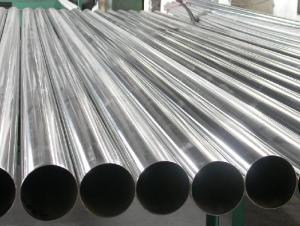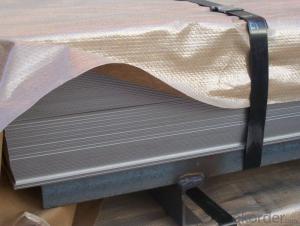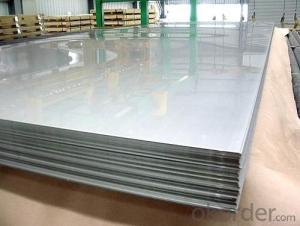stainless steel plate and sheet 420
- Loading Port:
- Tianjin
- Payment Terms:
- TT OR LC
- Min Order Qty:
- -
- Supply Capability:
- 5000 m.t./month
OKorder Service Pledge
Quality Product, Order Online Tracking, Timely Delivery
OKorder Financial Service
Credit Rating, Credit Services, Credit Purchasing
You Might Also Like
grade | 201,301,304,310,316,410,420,430,etc. |
surface | 2B,NO.1, NO.4, Mirror, Hairline, etc. |
thickness | 1MM, |
width | 1200MM,1220MM,1500MM,ETC. |
length | 2400MM,2440MM,3000MM,ETC. |
Payment terms | T/T, or L/C. |
Delivery time | Normally within 1 weeks after get your deposits. |
package | Standard export package, normally with wooden pallets |
MOQ | 5 tons/each size |
Our stainless steel sheet have different grades and surfaces,
we have some stocks in warehouse, so , our delivery time is very short.
- Q: How do you remove rust or corrosion from stainless steel sheets?
- To remove rust or corrosion from stainless steel sheets, you can follow these steps: 1. Start by cleaning the surface of the stainless steel sheet with a mild detergent and warm water. This will remove any dirt or grease that could potentially interfere with the rust removal process. 2. After cleaning, thoroughly dry the sheet to prevent any further water damage and to ensure the rust removal process is effective. 3. Next, use a non-abrasive scrubbing pad or a soft cloth to apply a stainless steel cleaner or a homemade solution made of equal parts vinegar and water. Gently rub the affected area in the direction of the grain of the stainless steel. 4. If the rust or corrosion persists, you can try using a paste made of baking soda and water or a mixture of cream of tartar and water. Apply this paste to the affected area and let it sit for about 15 minutes. Then, scrub the area gently with a soft cloth or a non-abrasive scrubbing pad. 5. If the above methods do not fully remove the rust or corrosion, you can try using a commercial rust remover specifically designed for stainless steel. Be sure to follow the instructions provided by the manufacturer and use appropriate safety precautions. 6. After removing the rust or corrosion, rinse the stainless steel sheet thoroughly with clean water and dry it completely to prevent any water spots or further damage. 7. To prevent future rust or corrosion, it is recommended to regularly clean and maintain stainless steel surfaces using non-abrasive cleaners and avoiding harsh chemicals or abrasive materials. Remember to always test any cleaning solution or rust remover on a small, inconspicuous area of the stainless steel sheet before applying it to the entire surface, to ensure it doesn't cause any damage or discoloration.
- Q: Can stainless steel sheets be used for water treatment equipment?
- Indeed, water treatment equipment can indeed utilize stainless steel sheets. The exceptional resistance of stainless steel to both corrosion and oxidation renders it an optimal substance for water treatment purposes. In fact, it is frequently employed for the construction of tanks, pipes, valves, and other essential components within water treatment systems. Due to its durability and hygienic attributes, stainless steel proves itself capable of handling diverse forms of water, ranging from potable water to wastewater and industrial process water. Furthermore, stainless steel's effortless cleaning and maintenance procedures guarantee the longevity and effectiveness of water treatment equipment.
- Q: Can stainless steel sheets be used for wall paneling?
- Certainly! Wall paneling can be done using stainless steel sheets. Stainless steel is a versatile material that is famous for its durability, ability to resist corrosion, and attractive appearance. It is widely used in various applications, including wall paneling in both residential and commercial settings. Installing stainless steel sheets as wall panels is a breeze, giving the space a contemporary and elegant look. Moreover, stainless steel is effortless to clean and maintain, making it a practical choice for wall paneling in areas that require frequent cleaning, such as kitchens and bathrooms. In summary, stainless steel sheets are an excellent choice for wall paneling due to their long-lasting nature, aesthetic appeal, and ease of maintenance.
- Q: How do you install stainless steel sheets?
- To install stainless steel sheets, you will need a few basic tools and follow these steps: 1. Measure and prepare: Start by measuring the area where you want to install the stainless steel sheets. Ensure that the surface is clean, dry, and free from any dust or debris. If needed, sand down any rough spots or imperfections on the surface. 2. Cut the sheets: Using a metal cutting tool like a circular saw or a jigsaw with a metal cutting blade, cut the stainless steel sheets to the desired size and shape. Make sure to wear safety goggles and gloves while cutting to protect yourself. 3. Apply adhesive: Apply a high-strength construction adhesive to the backside of the stainless steel sheet. Make sure to apply the adhesive evenly, leaving no gaps or air pockets. You can also use a notched trowel to spread the adhesive for better coverage. 4. Position and secure: Carefully place the stainless steel sheet onto the prepared surface, making sure to align it properly. Apply gentle and even pressure to ensure the sheet adheres to the surface. You can use a roller or a clean cloth to press the sheet firmly onto the surface. 5. Secure with screws: If necessary, use stainless steel screws to secure the sheet further. Place the screws along the edges and corners, ensuring they are evenly spaced. Make sure not to overtighten the screws to avoid damaging the sheet. 6. Trim and finish: If any excess stainless steel sheet is hanging over the edges, use a metal cutting tool to trim it down to the desired size. Once trimmed, smooth out any rough edges using a file or sandpaper. You can also use a stainless steel cleaner to remove any smudges or fingerprints and give it a polished finish. Remember to always follow the manufacturer's instructions for the specific stainless steel sheets you are using, as installation methods may vary slightly. Additionally, it is recommended to seek professional assistance if you are unsure or not comfortable with the installation process.
- Q: How do I prevent discoloration on stainless steel sheets?
- To prevent discoloration on stainless steel sheets, there are a few measures you can take: 1. Regular cleaning: Stainless steel sheets should be cleaned regularly using mild soap or a stainless steel cleaner. Avoid using abrasive cleaners or scrubbing brushes, as they can scratch the surface and make it more prone to discoloration. 2. Avoid harsh chemicals: Avoid using harsh chemicals, bleach, or chlorine-based cleaners on stainless steel sheets, as they can cause discoloration. If any spills occur, clean them immediately to prevent staining. 3. Proper ventilation: Ensure proper ventilation in the area where stainless steel sheets are installed. This is especially important in areas where chemicals or fumes are present, as they can react with stainless steel and cause discoloration. 4. Protective coatings: Applying a protective coating to stainless steel sheets can help prevent discoloration. There are various protective coatings available in the market designed specifically for stainless steel. These coatings create a barrier between the steel and external factors, reducing the chances of discoloration. 5. Regular maintenance: Regularly inspect the stainless steel sheets for any signs of discoloration or damage. Address any issues promptly to prevent further deterioration. By following these preventative measures, you can minimize the risk of discoloration on stainless steel sheets and maintain their aesthetic appeal for a longer period.
- Q: How can I classify stainless steel plates?
- Classification according to the use of stainless steel, can be divided into: the bridge plate, boiler plate, shipbuilding plate, armor plate, automotive steel, steel roof, structural steel, electrical steel (steel sheet), special spring steel, solar panels (hoilik steel).
- Q: What drill can drill stainless steel?
- Carbide bit: a drill used in core drilling. The cylindrical steel bit is named after the carbide cutting tool with tungsten carbide. The shape of cemented carbide cutting tools, the number of them arranged on the drill bit, the arrangement and the welding angle are called the bottom, the inner edge and the outer edge, so as to ensure the clearance between the water and the powder. The upper part of the drill body is threaded connection tube, a drill bit body are arranged at the side part of the sink, the bottom surface is provided with a nozzle lip. Both the water tank and the water inlet ensure the circulation of the washing fluid, so as to eliminate the influence of the rock powder and the cooling bit. When drilling into the clay and shale formations, the ribs are welded to the inner and outer sides of the hard alloy drill bit in order to increase the gap, called the rib bit. Self drilling bits with needle like carbide can be used in hard formations with high abrasive properties. Rock drillability is a grade II VII formation general hard alloy drilling; acicular carbide drill drilling a rock grade VI viii.
- Q: What are the costs of stainless steel sheets compared to other materials?
- The costs of stainless steel sheets tend to be higher compared to other materials such as aluminum or carbon steel. This is primarily due to the higher production and fabrication costs associated with stainless steel, as well as its superior corrosion resistance and durability, which make it a popular choice for various applications. However, it's important to consider the long-term benefits and value that stainless steel offers, making it a worthwhile investment in many cases.
- Q: What is the area of stainless steel plate?
- First of all, I said, can not be sold by area, because the thickness of the price is not the same, I said the weight is how to draw, take SUS304 steel:Length (m) * width (mm) * thickness (mm) * density (7.93) /1000= weight
- Q: How do I determine the size and dimensions for stainless steel sheets?
- To determine the size and dimensions for stainless steel sheets, you need to consider the specific application and requirements. First, measure the area where the sheet will be installed or used, taking into account any necessary overlaps or allowances. Next, consider the thickness or gauge of the sheet that best suits your needs, as stainless steel sheets are available in various thicknesses. Additionally, consult with suppliers or manufacturers who can provide guidance based on your specific project requirements.
Send your message to us
stainless steel plate and sheet 420
- Loading Port:
- Tianjin
- Payment Terms:
- TT OR LC
- Min Order Qty:
- -
- Supply Capability:
- 5000 m.t./month
OKorder Service Pledge
Quality Product, Order Online Tracking, Timely Delivery
OKorder Financial Service
Credit Rating, Credit Services, Credit Purchasing
Similar products
Hot products
Hot Searches
Related keywords
























